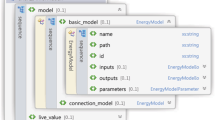Abstract
Energy is a core part for the sustainable development of machine tool industry; its intensity and utilization has become increasingly important with the concern over global climate change. Machine tools, as a vital part of energy consumption, have major significance for energy savings and carbon emissions. To achieve such energy savings, a precise energy model of a machine tool is a primary register to provide decision support for energy efficiency evaluation and optimization. As there are numerous machine tool components and each with its own characteristic energy signature, the energy consumption of a machine tool has a complex multi-source and dynamic characteristic. To describe such characteristic, a new methodology of energy modeling is proposed with the components working states of machine tools. Firstly, the components of a machine tool are divided into two classifications according to their energy characteristics, i.e., time-varying units (TVUs) and non-time-varying units (NTVUs). Secondly, the working states and coupling relationship of TVUs and NTVUs are studied, and a segmented energy modeling method of TVUs and NTVUs is proposed. Thirdly, the work state execution and coupling relationship of TVUs and NTVUs are combined into a description model of machine tools based on the Business Process Model and Notation (BPMN), and the energy data association of the model is also studied. Finally, a case study of computer numerical control (CNC) milling machine is given to verify the effectiveness of the proposed model.
Similar content being viewed by others
References
Kone AC, Buke T (2010) Forecasting of CO2 emissions from fuel combustion using trend analysis. Renew Sust Energ Rev 14(9):2906–2915. https://doi.org/10.1016/j.rser.2010.06.006
Parry ML, Canziani OF, Palutikof JP, Vander PJ, Hanson CE (2007) Impacts, adaptation and vulnerability, contribution of working group II to the fourth assessment report of the intergovernmental panel on climate change. Cambridge University Press
Zhu S, Jiang ZG, Zhang H (2017) A carbon efficiency evaluation method for manufacturing process chain decision-making. J Clean Prod 148:665–680. https://doi.org/10.1016/j.jclepro.2017.01.159
National Bureau of Statistics of the People’s Republic of China (NBSC) (2010) China statistical yearbook 2010. China Statistics Press, Beijing
International Energy Agency (IEA) (2007) Tracking industrial energy efficiency and CO2 emission. OECD/IEA, Paris
Electronic Industries Association (EIA) (2008) U.S. carbon dioxide emissions from energy sources 2008 flash estimate
Jiang ZG, Zhou TT, Zhang H, Yan W, Cao HJ, Tian GD (2016) Reliability and cost optimization for remanufacturing process planning. J Clean Prod 135:1602–1610. https://doi.org/10.1016/j.jclepro.2015.11.037
Li CB, Tang Y, Cui LG, Li PY (2015) A quantitative approach to analyze carbon emissions of CNC-based machining systems. J Intell Manuf 26(5):911–922. https://doi.org/10.1007/s10845-013-0812-4
Mori M, Fujishima M, Namasu YI, Oda Y (2011) A study on energy efficiency improvement for machine tools. CIRP Ann Manuf Technol 60(1):145–148. https://doi.org/10.1016/j.cirp.2011.03.099
Vincent AB, Paul TM (2013) Modeling of direct energy requirements in mechanical machining processes. J Clean Prod 41:179–186
Dietmair A, Verl A (2009) Energy consumption forecasting and optimization for tool machines. J Mod Mach Sci 3:62–67
Herrmann C, Thiede S (2009) Process chain simulation to foster energy efficiency in manufacturing. CIRP J Manuf Sci Technol 1(4):221–229. https://doi.org/10.1016/j.cirpj.2009.06.005
Liu F, Liu S (2012a) Multi-period energy model of electro-mechanical main driving system during the service process of machine tools. J Mech Eng 48(21):132–140. https://doi.org/10.3901/JME.2012.21.132
Liu S, Liu F, Wang QL (2012b) Energy efficiency acquisition method for electro-mechanical main driving system during the service process of machine tools. J Mech Eng 48(23):111–117. https://doi.org/10.3901/JME.2012.23.111
Wang QL, Liu F, Wang XL (2014) Multi-objective optimization of machining parameters considering energy consumption. Int J Adv Manuf Technol 71(5-8):1133–1142. https://doi.org/10.1007/s00170-013-5547-z
He Y, Liu F, Wu T, Zhong FP, Peng B (2012) Analysis and estimation of energy consumption for numerical control machining. J Eng Manuf 226(2):255–266. https://doi.org/10.1177/0954405411417673
Hu SH, Liu F, He Y, Hu T (2012) An on-line approach for energy efficiency monitoring of machine tools. J Clean Prod 27:133–140. https://doi.org/10.1016/j.jclepro.2012.01.013
Lv JX, Tang RZ, Jia S (2014) Therblig-based energy supply modeling of computer numerical control machine tools. J Clean Prod 65:168–177. https://doi.org/10.1016/j.jclepro.2013.09.055
Gong YQ, Lv M, Wang G, Zhou K (2007) Research on process knowledge management based on ontology. IEEE Int Conf Commun Serv Knowl Eng 5385–5388
International Organization for Standardization (ISO) (2014) Machine tools—environmental evaluation of machine tools—Part1: design methodology for energy-saving machine tools. ISO 14955–1
Michele C, Alberto T (2012) BPMN: an introduction to the standard. Comput Stand Interfaces (34):124–134
Cai ZL, Yi SP (2010) Business process integration modeling method based on business modeling notation. Comput Integr Manuf Syst 16(3):551–557
Object Management Group (OMG) (2012) Business Process Model and Notation (BPMN) Version 2.0 [EB/OL]. [2010–07-14]. http://www.omg.org/spec/BPMN/2.0/Bata2. OMG Document Number: dtc/2010–05-03
Shi JL, Liu F, Xu DJ, Xie D (2010) Power balance equation about the numerical control machine tool’s main driver system driven by variable voltage variable frequency. J Mech Eng 46(3):118–124. https://doi.org/10.3901/JME.2010.03.118
Gu SG (2007) Fundamentals of electrical machines and drives. China Machine Press, Beijing
Chen RY (2002) Metal-cutting principles. China Machine Press, Beijing
Acknowledgments
The authors are grateful for the research support from the National Natural Science Foundation of China (Nos. 51775392 and 51675388), the National Hi-Tech Research and Development Program of China (No. 2014AA041504), and the Foundation of Wuhan University of Science & Technology (2015X2049).
Author information
Authors and Affiliations
Corresponding author
Rights and permissions
About this article
Cite this article
Wei, Y., Hua, Z., Zhi-gang, J. et al. A new multi-source and dynamic energy modeling method for machine tools. Int J Adv Manuf Technol 95, 4485–4495 (2018). https://doi.org/10.1007/s00170-017-1545-x
Received:
Accepted:
Published:
Issue Date:
DOI: https://doi.org/10.1007/s00170-017-1545-x



